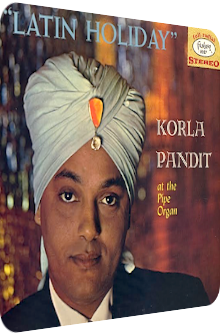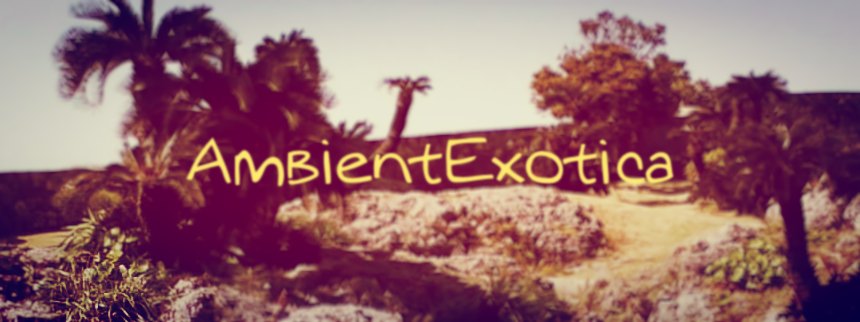
Korla Pandit
Latin Holiday
1959
Welcome to another review of a Korla Pandit album. After the gloominess of his hallmark Music Of The Exotic East (1958) and the scattered darkness that worked quite well on Tropical Magic (1959), it is time for the opposite spectrum. John Roland Redd (1921–1998), the man behind the stage persona Korla Pandit, had many interesting things in store, and so it happens that Latin Holiday was released in 1959 on the Fantasy label. Much to the chagrin of fans who prefer the darker, opaque kind of Exotica, Latin Holiday is a shimmering ruby of an album, comprising of a sugar-sweet luminosity, piles of different organs and a joyful mood. But that’s not all: the concept of overexposure is imprinted on each and every of the 12 tunes, ten of them renditions plus two original cuts. Each presented mood is well-saturated, be it the esprit and pride found in many a Latin tune, the fairy tale tone sequences on a lot of the arrangements or the occasional gloominess which Pandit is known for.
Latin Holiday will be remembered as the fake Indian’s glitziest, most colorful album, but the darker undertones spice the syrupy gallimaufry in a decided and dedicated manner. It seems to me as if Redd really tries to present a wider range of textures and surfaces on this release than ever before. He even widens his pipe organ-focused limitation a bit by admixing a classic piano. Its inclusion is nothing new per se, it is the steadiness in which it appears, making it almost a commodity. The only remaining devices consist of castanets and tambourins, but it is never entirely sure whether they are real-world instruments or only created via a cleverly tweaked organ preset. Since Korla Pandit was a maestro in this regard, anything is possible. I deem Latin Holiday to be his most vivid and successful work, but be careful: three songs in, and you might already have enough. It is the proper dose and the right circumstances which either make this album work flawlessly or fail miserably. I mention a few quirky ideas throughout the review. Maybe you can relate to them.
Wow. Just wow. The opener España Cañí (simply named España on the back sleeve), originally written by Pascual Marquina Narro around 1925, is turned into one of the most glaring hockey hymns by Korla Pandit. Even if the listener does not recognize the title, he or she sure has encountered the melody at one time. The staccato torrero flourish that is so world-famous is played on a coruscating, blithesome pipe organ that foreshadows the texture of the early 90’s Rave (!) movement with pristine clarity. Sure enough does Pandit mix castanets and tambourins to enhance the jocular atmosphere. This is a Space-Age masterstroke par excellence, even more so when the organ is tweaked to resemble an Oriental shawm. This is most definitely not for everyone, but it is for sure one – if not the – most comical of the faux-Indian’s renditions. The vignette-like structure of glueing the different phases of this originally orchestral piece together seems like a string of different melodies or short samples, but these were indeed all envisioned by Narro heretofore. A gorgeous first piece! Korla Pandit’s own
No Me Quiero Tantos follows next, and it resembles almost an Italian sun-soaked vista of warmth rather than a Latin landscape. The staccato organ bells glisten in adjacency to the legato Rimini organ; there is even a classic piano aorta meandering below the wealth of its textures. A highly bedazzling piece of brightness and Old Europe-evoking holiday feelings.
While Pyotr Ilyich Tchaikovsky’s waltz Festival Of Flowers has survived the transformation into an organ piece astonishingly well due to their texture resembling a colorful crystal cave which is situated next to the voluminous warm-hearted pipe organ, Edward Eliscu’s Orchids In The Moonlight which he co-wrote with Gus Kahn and Vincent Youmans unleashes an abyssal nocturnal atmosphere, with the Latin flavor completely diminished in favor of Halloween-esque old castle organs, a haunting polyphony and the occasional mercurial segue. Spectral whispers are added in the second half, boosting the cold creepiness. The incessant shifts between Gothic traditions and a lachrymose euphony make this a feast for fans of Korla Pandit’s much darker Tropical Magic from 1959 as well.
Estrillita by Manuel Ponce is next, and it opens the stylistic formula further: an epicurean incandescence of transfiguring faux-strings serves as the prologue and remains surprisingly close to Ponce’s original vision. A classic piano full of grandeur and short boosts of organ underpinnings make this the highly romantic and least cheeky Ambient-oid track of Latin Holiday. Side A closes with Agustín "Agust" Lara’s famous Granada. It is here where the pompous Latin grandeur is resurrected in a gargantuan way: a thicket of tambourins and castanets gyrates around a boasting melody, further rhythm changes and ever-changing shifts in timbre make this a truly great example of bachelor pad music. Everything is in there, from short capsules of bile over granular pride to the exaggerated fanfare at the end. It is a great – and second to none – interpretation of a hymn.
Side B opens with Enrique Pedro Maroni’s and Gerardo Matos Rodríguez’s tango La Comparsita (actually La Cumparsita). The compassion and devotion in the few piano sprinkles is expectedly normal, but does not translate well in the organ setting; all the better, I say! The blood-red creepiness of the intimidating pipe organ make this suitable music for ghostly apparitions on forlorn graveyards. La Cumparsita is a splendid inclusion to your next Halloween party, mark my words. The following two tracks are very much alike and base on a previous mood: whereas Billy Rose’s and Mabel Wayne’s It Happened In Monterey harks back to the enchanted reverie of Tchaikovsky’s Festival Of Flowers texture-wise with rhythmic iridescent glints and a slightly creepy balm of ghostly organ streams, the traditional Folk dance Las Mañanitas picks up the fluffy pastel-colored aura and… well, does not do anything hugely different. A classic piano is added at times, but that’s it.
It is Consuelo Vel’s Bésame Mucho that changes the soundscape, as this is a spectacularly Latin ballad. Organs of heartache, crestfallen piano drops and towering organs chords make this a creepscape that is even beyond the sensual driving force Señorita Vel once felt while sitting on her piano. The following Maria Bonita is the second piece by Agustín Lara on this LP and surprises with string-like organs, a funny organ grinder-evoking carnival feeling and gentle pianos. Especially the intermission shocks with a moment of solemnity in-between the otherwise mocking surroundings. The album closes with another original track by Mr. Pandit himself: Joyful Tango proves to be great music for a hop or polonaise, although your friends will then tend to eschew you. This is the most saccharine tune, only very shortly perturbed by an über-dark grave string. Most of the time, chords in major ooze out of every pore. The castanets and the humping piano round off a bright tune which increases its alienation as it progresses.
Even though there is a dichotomy of pernicious Halloween tunes and an overexposed conviviality on Latin Holiday, this LP remains Korla Pandit’s most gleeful work of all times. Its title stresses the vacation-related aspect, and sure sure, one might use it on a family road trip in order to teach the partaking passengers a good lesson or two, but this music is best enjoyed – if living conditions allow – in a bachelor’s den. In the end, the album lives up to the promise of its title, as the Latin aspects are definitely there, the overacted pompousness of hits like Granada and España Cañí is well-transformed by the pipe organ together with the remaining equipment. The prominent inclusion of a real piano on a lot of the material can either be interpreted as Pandit taking a bow for the humble inceptions of the presented cuts, or his conclusion that he cannot mimic or mock each and every instrument with the help of his organs. The piano is hence a standout exceptional case in the soundscape.
The hypnotizing TV persona has used this instrument on many of his albums, so I do not want to overstress its inclusion here, but the regularity in which the piano occurs is definitely noteworthy. Fans will rejoice due to the definitely darker sections which are still found aplenty on Pandit’s brightest release; he just cannot let loose and unchains a deliberately distasteful creepiness on tunes like La Cumparsita and Orchids In The Moonlight. They do not match the spine-tingling crypt that is Tabu on his album Tropical Magic, but come very close. And huzzah, things get really interesting when a short cacophony or frightening dissonance is suddenly injected in the many spun sugar cotton candy anthems he comes up with here. If you love Korla Pandit for his darker pieces, this is an album you should stay away from, but only because it features the least bit of them, though once the murkiness hits, you are in for a treat. Pestering people with the gooey saccharose of tunes like Festival Of Flowers or Las Mañanitas may turn out to be a funny torture method. Finally, ice hockey fans will relate to the gargantuan hymnic quality of the opener España Cañí, a melody that is world-famous and ubiquitously played by orchestras all around the world just as you are reading this line, but has never been featured in an organ version before 1959. A huge favorite! Luckily, the album is indeed available as a digital download on iTunes and Amazon. For the love of bachelor pads, pre-listen to the songs mentioned above if you do not know the album or that strange artist yet; you won’t trust your ears!
Exotica Review 181: Korla Pandit – Latin Holiday (1959). Originally published on Feb. 16, 2013 at AmbientExotica.com.
